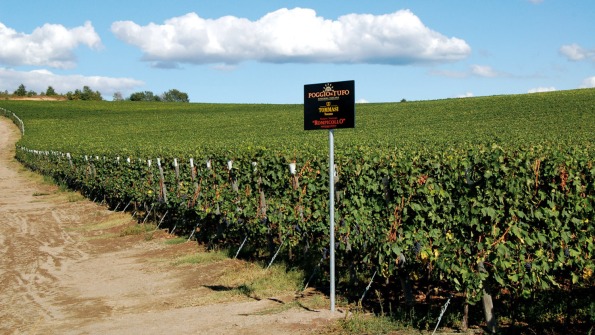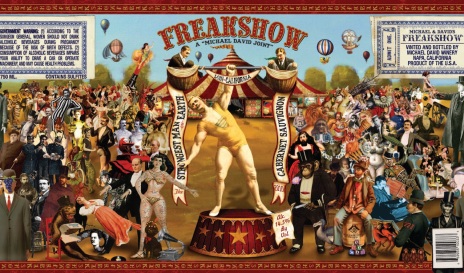Archive
Winter nights warmed by memories of Etruscan vineyards.

The Tommasi Family’s Poggio al Tufo vineyards near Pitigliano, a historical Etruscan city in the Maremma an hour or so north of Rome. Photo courtesy Tommasi Family Estates.
Sometimes, when the days are short and cold and summer is but a memory, I spend winter hours looking for wines that remind me of warmer times and sunnier climes.
I recently found two wines that took me back to a few days late last spring spent wandering the vineyards of the Veneto and Tuscany. Both wines are from Tommasi Family Estates, the 115-year old company now in its fourth generation of winemakers with its base in the heart of the Valpolicella Classico region of the Veneto.
Tommassi, named after founder Giacomo Tommasi, has vineyards in four regions: Veneto; Olto Pavese in Lombardy; Tuscany (Montalcino and Maremma); and Manduria, in Puglia. From each of these regions come wines as distinct and unique as the vineyards where they grow.
The event was a simple gathering of good friends for a holiday dinner and talk, a simple yet warm get-together so remindful of previous dinners spent at the homes of winemakers around the world, where formality drops away and the talk turns to the state of wine in general along with family, current politics and wherever the mood take us.
Tommasi Ripasso DOC Valpolicella Classico Superiore 2013 – As we all know, the story of Ripasso wines is intertwined with the story of Valpolicella and Amarone. Briefly, a Ripasso is made by refermenting Valpolicella on the skins left after Amarone is fermented. The result is a wine that’s darker and more intense in flavor than the original Valpolicella and goes well with winter-style comfort foods or even a grilled steak in the summer.
You could call a Ripasso a “baby Amarone” because the former uses the same grape varieties that go in Amarone (Corvina, Rondinella and, in this case, Corvinone) and you get some of the same aromas: dark cherries, dried cranberries, heather, and spice.
But it’s less-expensive, generally in the $20-25 range.
We had this wine with grilled chicken, fresh green salad and homemade bread. You would have thought it was July until the wind howled and snow blew past the windows.
Tommasi Poggio al Tufo Rompicollo Toscana IGT 2013 – We opened this wine for the cheese course and while there’s nothing overwhelming about the wine, it brought a smile to everyone’s face. Maybe that’s the key – it’s not overwhelming, it just goes well with food and good company.
Plus, it’s one of those rare finds that is affordable, very tasty and pairs well most lighter meats, pastas and cheeses. And, if you’re into this sort of thing, you can close your eyes, take a sip and imagine you’re in the Tommasi vineyard in the historic Etruscan area of sunny Maremma in southwestern Tuscany, midway between the Tyrhennian Sea and Rome.
The wine is a blend (60 percent Sangiovese, 40 percent Cabernet Sauvignon) from a sun-drenched vineyard on volcanic soil. The word “tufo” is Italian for the volcanic tuff found in the Maremma and a common building stone for Rome. The wine has bright flavors of dried Montmorency cherries, currants and hints of sage and white pepper. $12-$15.
Both wines are imported by Vintus Wines, Pleasantville, N.Y.
A brief sampling of Lodi wines

The entertaining label from the Michael David 2010 Freakshow Cab hints that this isn’t your typical California cabernet sauvignon or typical winery, for that matter.
It’s getting late – not in the day but in the year – and I’m catching up with some of the bottles sitting empty around my place.
Winter came late for western Colorado. A couple of weeks ago it still was 50 degrees in mid-afternoon but that changed just in time for a white Christmas. As I write this, there is light snow and 11 degrees headed south to around zero.
Which means I’m looking for something a bit stouter than pinot grigio to put in my class. Not that I have anything against pinot gris/grigio; it’s a great summer/fall wine.
But it’s obviously not summer.
I recently received a some samples from Michael David Winery, the Lodi, Cal. winery named after brothers Michael J. and David J. Phillips. The Phillips family farm dates to the 1860s according to the winery website, and while it mostly grew vegetables, the operation survived Prohibition by growing “15 different wine varietals that were shipped throughout the country during Prohibition with instructions on ‘how not to have the grapes turn into wine’.”
Michael started the winery in 1984 and now he and David are the fifth generation of Phillips to farm the land. Their aim, according to the website, is “to show the world of wine drinkers that wines made from Lodi grapes can compete against wines from anywhere in the world.”
Incognito 2010 Red Wine – A complex blend of seven varietals based on syrah (40 percent), this wine offers the cherry and dark berry flavors along with a hint of spice. Medium tannins, 14.5 alcohol. $18. There also is an Incognito white blend.
Sixth Sense 2010 Syrah – Syrah is a favorite varietal at Michael David and these vines date from 1982, making them some of the oldest syrah vines in the California. Sort of named after Michael’s son Kevin, now the sixth generation of Phillips growing grapes. Syrah with some “Petite Sirah blended in,” according to the press sheet.
Big, bold and intense with dark-red cherry and plum fruit, a bit of smoke, coffee but still a balance of acid and tannins. 15.5% alcohol. 88 points from Wine Spectator, July 2012. $16.
Freakshow 2010 Cabernet Sauvignon – The only wine I can think of with a subtitle, in this case “A ‘Michael David Joint’.”
Michael David makes big wines and this is one of their biggest. Big-bodied but not overwhelming, with dark cherry, spice, blackberry, a hint of dried raisins and dark oak. Mellow tannins. Would have been great with barbecue last summer. Or next. 14.5% alc. $20.
7 Deadly Zins – The brothers Phillips call this their flagship zin and it’s lived up to that with steady consistency. It feels like a bit hotter alcohol than the 15% alcohol on the label but that’s just being picky. True to the varietal with plenty of berry fruits, pepper and spice. $16.
Wine prices may rise as ocean of bulk wine shrinks
Don’t be surprised to see wine prices increase this year, says the always entertaining and informative writer W. Blake Gray on his blog, The Gray Market Report.
Gray lists smaller vintages oin California, Italy and Spain as warning signs that the world’s ocean of wine has shrunk considerably over the past few years, forcing prices up as demand, particularly in the U.S., continues to grow.
Forget arguing over to what degree quality affects wine prices, he says.
“Pricing is all about supply and demand,'” Gray writes in his latest blog entry.
His argument makes sense: As stocks of bulk wines shrink, distributors will be harder pressed to satisfy the demand from consumers accustomed to finding California Cabs for $20.
Bulk wines include not only the lesser-quality juice commonly used for blending but also situations where top wineries have produced more wine than they can sell and market that surplus to small-company labels or to mass-market distributors (think Bronco Wine Company’s popular “Two-Buck Chuck”) for private label bottling.
Bulk-wine volumes in California (those being sold by vintners to other vinteners) reached 15 million to 20 million gallons since 2000, according to a report in the Jan. 19 issue of North Bay Business Journal out of Sacramento, Cal.
The story, citing Brian Clements and Marc Cuneo of Novato (Cal.)-based Turrentine Brokerage at the 21st annual Sonoma County Winegrape Commission Dollars & Sense seminar, said aggressive marketing efforts by wineries to reduce that inventory, along with the three successive smaller harvests, “have siphoned the bulk-wine inventory down to 4 million gallons now.”
The varietal most affected, the grape brokers said, has been cabernet sauvignon.
“This is the first time I’ve been involved in a market flip that was not about sales,” Mr. Clements said. “This flip has been about inventory.”
“If wine sales continue as they have, we can look for a very deep shortage of cab in the North Coast,” he said.
Clements also warned of a potential shortage of chardonnay, which continues to be the favorite white wine of American consumers and, according to Reuters, the No. 1 white wine in the world.
Subpar vintage means no harvest for Hidden Ridge
Here’s something you don’t read every year: A top-quality Napa winery has decided to not harvest its grapes this year.
According to a release from Kathy Jarvis at Jarvis Communications in Culver City, Hidden Ridge Vineyard owners Casidy Ward and Lynn Hofacket have opted to not harvest any fruit from their 60-acre vineyard on Spring Mountain due to what Ward and Hofacket call an “inconsistent growing season.”
Several writers and bloggers have commented on the difficult 2010 vintage for northern California (including Alder here) but this is the first report I’ve seen that someone decided the grapes weren’t good enough to pick. While Ward and Hofacket said it was difficult decision to go without a 2010 vintage wine for their Cabernet Sauvignon the choice is in line with their commitment to produce only the best wines possible.
According to a statement issued by Ward and Hofacket, the fruit simply wasn’t up to their tight standards.
“The wonderful thing about our Hidden Ridge Vineyard is that we’re able to capture the flavors of this rare and special place in a bottle from year to year,” said Ward. “Our vineyard truly expresses each year’s growing season and all of the wonderful variants each year brings. Our wines may not taste the exactly the same every year, but they do need to taste great.”
He said the decision to not harvest was made with the approval of his winemaking team of Marco DiGiulio and Timothy Milos.
Hidden Ridge includes some high elevation (up to 1,700 feet), extremely steep vineyards (up to 55 degrees, according to the winery’s website, which puts them in the almost-as-steep-as-Switzerland category) which even in the best years don’t overproduce grapes.
You’d think this Cabernet Sauvignon would reach the stratospheric prices demanded by other Napa producers but at $40 a bottle, Hidden Ridge remains in the affordable range.
Because it’s so difficult and labor-intensive to harvest the grapes in this remote vineyard in the Mayacamas Mountains between Sonoma and Napa counties (access is by foot, 4-wheel truck or helicopter), the owners and winemakers decided to simply leave the grapes instead of harvesting them and trying to sell them on the bulk market.
While it’s not unheard of for a winery to skip a vintage or two, it must have been a difficult decision in the ultra-competitive world of California Cabernet Sauvignon.
Winemaking is an endeavor where you get but one chance a year to make your reputation.
Ward and Hofacket are counting on their previous vintages, along with the mystique of being daring enough to not make a wine when the grapes aren’t of quality, to keep their reputation intact and their wines in demand.